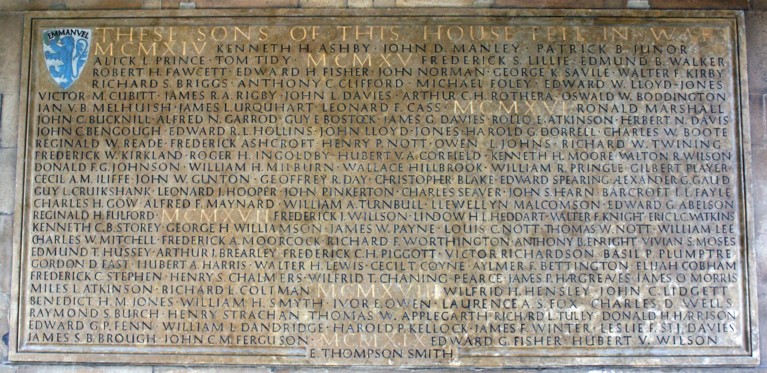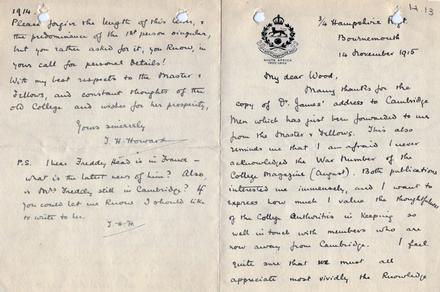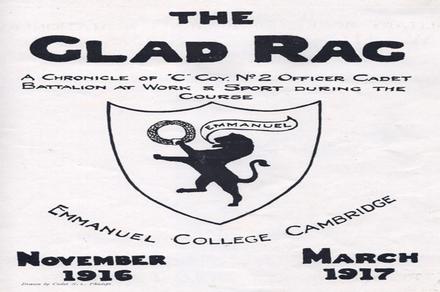World War I
During the ninteenth & early twentieth centuries, Emmanuel's popularity had been steadily increasing. In the summer of 1914, it was looking forward to welcoming around 80 new students for the academic year.

However, due to the outbreak of war, there was a the wave of enthusiastic enlistment in the 'long vacation'. This reduced the number of admissions to 57, and depleted the numbers of second & third year students. The numbers continued to fall drastically over the next few years. They mainly consisted of men medically unable to fight and those wounded or discharged. After the war ended, there were overwhelming numbers of returning students: in 1919 there were 233 admissions.
The Fellowship, which in 1914 comprised the Master & 14 Fellows, had been reduced to half that size by 1916. Although only a few Fellows served in the army, many undertook other work. Two Fellows became army chaplains and two worked with the Field Ambulance service. One went to the Munitions Inventions Board and another to the Censor’s Office. The Fellowship also suffered one great loss: Geoffrey Day, a History Fellow. He was very popular with colleagues and undergraduates alike. He enlisted at the beginning of 1914, and was killed on the Western Front two years later. Fortunately, this was to be the only fatality among the Fellowship. Many of the College staff went to fight, and two were to be killed. As the war progressed, the number of regulations issued by the College increased. Happily, food rationing did not become necessary until 1917.

From 1914–1919, the newly built North Court was taken over by the War Office. The College Pavilion & Boathouse were also used. North Court housed officers on short training courses, mainly from the Welsh Fusiliers. Later in the war, men of the 'C' Company No.2 Cadet Battalion lived in North Court. In 1916 & 1917, they produced a 'Chronicle' of their time in the College, called 'The Glad Rag'. In 1918, another group of 'C' Company men produced a similar publication, entitled 'Cheerio'. This included a cartoon which proposed a new crest for Emmanuel.


The College kept in touch with as many serving men as possible. P. W. Wood, one of the College Fellows, preserved the letters he received from Emmanuel men. These were published as 'Letters from the Fronts' in the Wartime Editions of the College Magazine. Many of these soldiers served in areas around the world: many were stationed in Africa & India. Wood also sent the Magazine to his correspondents, and Captain Thomas Howard wrote in response. He talked of how much he valued the “thoughtfulness of the College Authorities in keeping so well in touch with members who are now away from Cambridge. I feel quite sure that we must all appreciate most vividly the knowledge that we are still remembered and still part of Emmanuel.”

Sadly, the death toll of Emmanuel men rose steadily as the war progressed: 5 killed in 1914, 19 in 1915, and 45 in 1916. Many men were stationed together, such as Thomas, Cameron & Paton Nott. These brothers served together in the Sixth Battalion of the Gloucestershire Regiment. They came to Emmanuel in 1907, 1912 & 1913 respectively. Paton was killed by shrapnel in April 1916. His commanding officer wrote that he had “never seen such grief displayed by all ranks over any previous casualty”. A year later Thomas & Cameron were killed together in their dugout at Villers Faucon. This was destroyed by a hidden German mine.

By the end of the war, almost 130 Emmanuel men had been killed. Their names are recorded on the College War Memorial. This was designed by the sculptor Ernest Gillick, and erected in January 1923.











